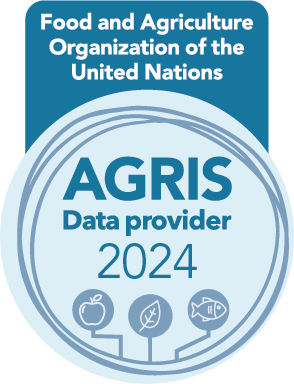Rise in the Physiological Quality of Seeds of Maize (Zea mays L.) Using Agricultural Bioproducts
DOI:
https://doi.org/10.5281/zenodo.8392603Keywords:
maize, germination, seed aging, Zea mays, TrychodermaAbstract
Context: One of causes of low yields in maize is the poor physiological quality of the seeds, which does not guarantee populations with the required technical parameters. Nationally, seed germination is fostered with the use of bioproducts in different species.
Aim: To determine the vigor and electric conductivity of maize seeds, using bioproducts after putting the seeds under accelerated aging conditions.
Methods: The experiment was done in laboratory III (Bioproducts for Agricultural Use), Faculty of Agricultural Sciences, Jose Marti Perez University of Sancti Spiritus, between October and December 2018. Seeds from four maize varieties provided by the Provincial Seed Company in Sancti Spiritus, were used. Francisco 28 (Fr-28), FgH, MAIG, and P-7928, and were combined with three bioproducts (T. harzianum, FitoMas E, and distilled water). A completely randomized experimental design was used, with factorial arrangement of 4x3x5.
Results: Bioproducts FitoMas E and T. harzianum proved to be effective in the recovery of seeds with physiological deterioration.
Conclusions: T. harzianum offered the best conditions to recover seed vigor, with 20 and 24% in relation to FitoMas E and the distilled water, respectively. The electric conductivity test proved its efficiency as a parameter to determine the vigor of seeds.
Downloads
References
Aristizábal. M., & Álvarez, L. P. (2006). Efectos del deterioro de la semilla sobre el vigor, crecimiento y producción del maíz (Zea mays). Agronomía, 14(1), 17-24. Retrieved on March 15, 2019, from: https://www.researchgate.net/profile/Manuel_Aristizabal_Loaiza/publication/221930198_Efectos_del_deterioro_de_la_semilla_sobre_el_vigor_crecimiento_y_produccion_del_maiz_Zea_mays/links/02faf4f6c9399ed411000000.pdf
Artola Zulueta, G. R. (2015). Utilización de diferentes biopreparados de microorganismos nativos multipropósitos en la germinación de semillas de maíz, frijol y arroz. Sancti Spíritus. (Tesis de grado no publicada). Universidad de Sancti Spíritus José Martí, Facultad de Ciencias Agropecuarias.
Cubillos Hinojosa, J. G., Páez Redondo, A., & Mejía Doria, L. (2011). Evaluación de la Capacidad Biocontroladora de Trichodrema harzianum Rifai. contra Fusarium solani (Mart.) Sacc. Asociado al Complejo “Secadera” en Maracuyá, Bajo Condiciones de Invernadero. Revista Facultad Nacional de Agronomía de Medellín, 64(1), 5821-5830. Retrieved on March 15, 2019, from: https://revistas.unal.edu.co/index.php/refame/article/download/26386/26737
Engels, M. M. J., & Visser, L. (eds.). (2007). Manuales de Bioversity para Bancos de Germoplasma No. 6. Guía para el manejo eficaz de un banco de germoplasma. Roma, Italia: Bioversity International. Retrieved on May 19, 2018, from: https://www.bioversityinternational.org/fileadmin/_migrated/uploads/tx_news/Gu%C3%ADa_para_el_manejo_eficaz_de_un_banco_de_germoplasma_1280.pdf
González Rodríguez, F., León Gómez, D., Borges Gómez, L., Pinzón López, L., Magaña Magaña, M., Sangines García, R., & Urrestarazu Gavilán, M. (29 mayo-junio de 2014). Envejecimiento acelerado sobre la calidad de semillas de maiz para producir germinados para forrajes alternativos. Revista Mexicana de Ciencias Agrícolas, (8), 1487-1493, doi: https://doi.org/10.29312/remexca.v0i8.1107
Hilmig, V., & Méndez Natera, J.R. (octubre de 2007). Relación de la calidad fisiológica de semillas de maíz con pH y conductividad eléctrica. FCA UNcuyo, 39(2), 91-100. Retrieved on February 4, 2019, from: http://bdigital.uncu.edu.ar/objetos_digitales/1643/vitoriaagrarias39-2.pdf
Manfrini, D. (september, 2004). Aspectos a tener en cuanta. Análisis del vigor en semillas. Revista del Plan Agropecuario, 56-58. Retrieved on February 4, 2019, from: https://www.planagropecuario.org.uy/publicaciones/revista/R111/R111_56.pdf
ONE. Ofina Nacional de Estadística e Información de la República de Cuba. (2017). Anuario Estadístico 2017 de Cuba. Ciudad Habana, Cuba: Consejo de Ministros. Retrieved on January 6, 2019, from: http://www.one.cu/aec2017.htm
Santana Baños, Y., Busto Concepción, A. del, González Fuente, Y., Aguiar González, I. Pedro Páez Fernández, L., & Díaz Lugo, G. (julio-septiembre de 2016). Efecto de Trichoderma harzianum Rifai y FitoMas-E® como bioestimulantes de la germinación y crecimiento de plántulas de tomate Centro Agrícola, 43(3), 5-12. Retrieved on January 6, 2019, from: http://cagricola.uclv.edu.cu/descargas/pdf/V43-Numero_3/cag01316.pdf
Tompsett, P. B., & Pritchard, H. W. (1998). The Effect of Chilling and Moisture Status on the Germination, Desiccation Tolerance and Longevity of Aesculus hippocastanum L. Seed. Annals of Botany, 82, 249-261, doi: https://doi.org/10.1006/anbo.1998.0676
Viñals Verde, M., García García, A., Montano Martínez, R. L., Villar Delgado, J. C., García Martínez, T., & Ramil Mesa, M. (septiembre-diciembre de 2011). Estimulante de crecimiento agrícola FITOMAS ®; resultados de producción del año 2010 y su impacto en cultivos seleccionados de alimentos. ICIDCA. Sobre derivados de la caña de azúcar, 45(3):15-23.
Downloads
Published
Issue
Section
License
Copyright (c) 2019 Michelle Leiva Arbolaes, Marcos Tulio García González, Marcia María Rodríguez Jauregui, Yander Fernández Cancio

This work is licensed under a Creative Commons Attribution-NonCommercial-NoDerivatives 4.0 International License.
You are free to:
- Share — copy and redistribute the material in any medium or format
- The licensor cannot revoke these freedoms as long as you follow the license terms.
Under the following terms:
- Attribution — You must give appropriate credit , provide a link to the license, and indicate if changes were made . You may do so in any reasonable manner, but not in any way that suggests the licensor endorses you or your use.
- NonCommercial — You may not use the material for commercial purposes .
- NoDerivatives — If you remix, transform, or build upon the material, you may not distribute the modified material.
- No additional restrictions — You may not apply legal terms or technological measures that legally restrict others from doing anything the license permits.






